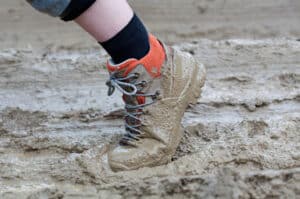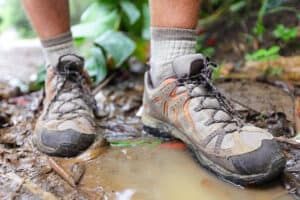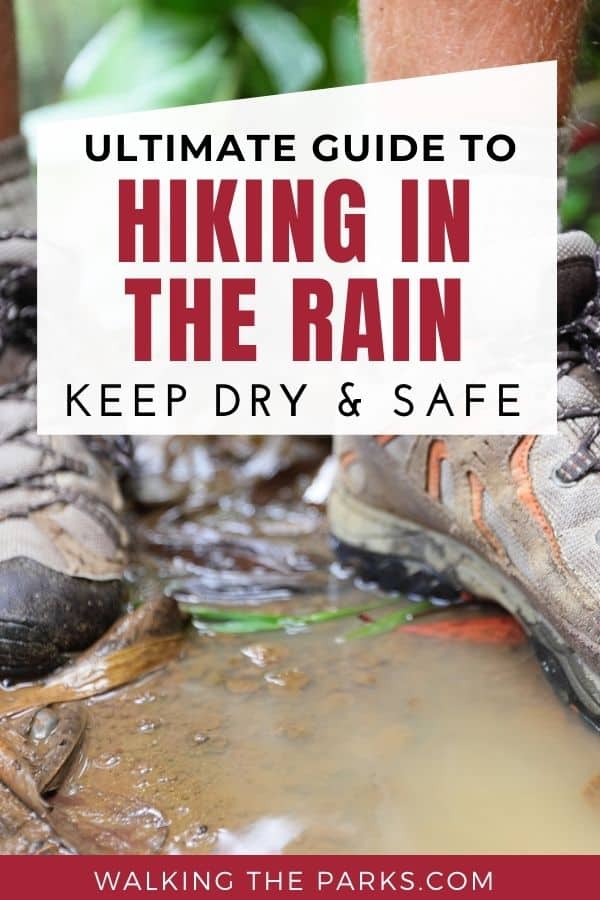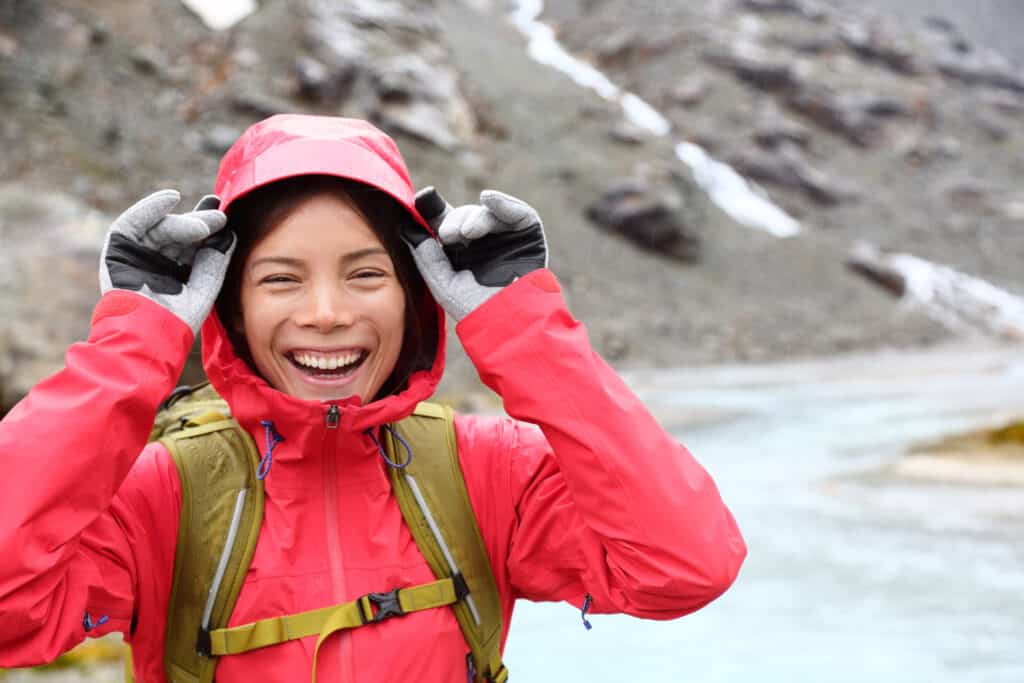The very reason you plan a hike in the rain, whether it be because today is your only day to do so or if you are in an area where it rains often, planning for your trek will ensure that not only do you stay dry but you also stay safe. Mostly though you want hiking in the rain to be fun!
Some people get really excited about hiking in the rain. They love the fresh smell of wet earth and the pitter-patter of little raindrops that fall with such a beautiful rhythm. The weather though can be very unpredictable; so it is important to keep safety in mind when you venture out into the rain.
We’re going to talk about why it is important to start your hike off with the right gear and how to successfully keep yourself dry. I think even more important is to talk about what to do if you do find yourself soaked to the bone.
Why Hike in the Rain?
Why on earth would anyone choose to hike in the rain you wonder…. well here’s our favorite reasons to get out and enjoy a rainy day.
![]() You’re Already There!
You’re Already There!
Let’s face it, the best reason to hike in the rain is because you are there! How often have you planned a hike only to find rain in the forecast? Or when on vacation, what are you going to do; just sit in your wet tent? So get out and enjoy it! Don’t let that silly rain stop your adventure. You just might find something totally unexpected.
![]() Breathe Fresh Air
Breathe Fresh Air
The rain is a natural filter to clean the air of pollens and smoke. Breathing in the fresh air on a rain hike is amazing. You’ll also find the smell of fresh clean air better than any fragrant candle. Hiking in the rain engages all your senses in new and interesting ways.
![]() No Crowds on the Trails
No Crowds on the Trails
Most people avoid the rain and think that when it rains, it is too muddy to hike on the trails. The result? Fewer people out there! As hikers, our biggest desire is to have a trail to ourselves so if you want to feel like one with nature, there is no better time than when there is no one else around.

![]() Rain Brings Unexpected Beauty
Rain Brings Unexpected Beauty
During a rainstorm, there are many sights to behold that you won’t find on a dry day. Waterfalls and creeks running full of fresh, clear water! The reflection of light in the prism of one drop on leaves. Walking through misty air can feel like walking into an alternative reality – it’s fantastic!
![]() Wildlife Viewing Can be Better on a Rainy Day
Wildlife Viewing Can be Better on a Rainy Day
Crazy as it sounds, many animals just go about their business in light rain. They have thick oily coats so the rain doesn’t bother them at all. And because the trail has fewer humans on it, they are less likely to shy away from the trail. That means you have a really good chance of spotting wildlife when hiking.
Then there are the critters that love water like salamanders and frogs. It’s a lot of fun to stop along the creek side to watch these animals in action.

![]() Beat SAD and Cabin Fever
Beat SAD and Cabin Fever
Cabin Fever and Seasonal Affective Disorder (SAD) are reoccurring conditions that can be combated with long hikes through the woods. Our bodies have a hard time adjusting to drastic weather changes, so being outside in nature is one of the best ways to combat SAD.
Our natural tendency is to hide inside when it’s raining, but that can only make it worse. Getting outside is what you need, so pull on that rain gear and take a short hike in nature.
Choosing the Right Trail for Rainy Hikes
Just because you’ve decided to hike in the rain doesn’t mean you should be naïve or stupid. By choosing the right trail you can have an amazing and safe hike. Who doesn’t love walking through the mist in the mountains or watching raindrops drip from the wildflowers?
Check the weather forecast – know before you go on your rainy hike!
Before you take your time getting out on that trail, it is important to check the weather forecast to see what it is going to be like. When rain is in the forecast, taking the necessary gear with you will help you stay dry and have a more enjoyable hike. Having an insight into what it is going to be like outside before heading out will keep you from being caught off guard and unprepared.
Thunderstorms with lightning are your biggest threat when hiking in the rain. Most hikers know that if lightning is in the forecast your best bet is to plan your hiking time around the lightning storm. And if the risk is high all day it’s a good day to stay in and do something else. Lightening is not something to mess with.
However more often than not hikers get surprised by a lightning storm. Here are lightening safety tips from the CDC if you do get caught:
AVOID: Avoid water. Avoid all metallic objects. Avoid the high ground. Avoid solitary tall trees. Avoid close contact with others – spread out 15-20 ft. apart. Avoid contact with dissimilar objects (water & land; boat & land; rock & ground; tree & ground). Avoid open spaces.
SEEK: Seek clumps of shrubs or trees of uniform height. Seek ditches, trenches or the low ground. Seek a low, crouching position with feet together with hands on ears to minimize acoustic shock from thunder.
KEEP: Keep a high level of safety awareness for thirty minutes after the last observed lightning or thunder.
If you are headed out into an area where it is likely to thunderstorm, make sure you have a way to get back down below tree line if lightning is sighted. The last thing that you want is to be stuck up there with no shelter if a storm hits and being caught on the side of a cliff or ridge will make you an easy target for lightning.
Be Aware of Trail Conditions when Selecting a Trail to Hike in the Rain
Some trails are better suited for hiking in the rain than others so make sure you know a little about the trail before you head out. The best trails for hiking in the rain are forested paths where the tree canopy provides a rain break. Slick rock trails are probably the worst in the rain because the rock lives up to its name and you’ll have a lot of trouble keeping your footing and balance.

Watch out for trails that turn into a real mess with mud. Of course, you made a choice to hike in the rain so mud is part of the fun. But it becomes a real problem if you have to go up or down a steep muddy incline. In that case, you’ll have to decide whether climbing is more or less dangerous than the muddy, slippery going. You don’t want to get stranded in a ravine or at the bottom of a rise that you just can’t get up because it is a muddy slide with no handholds to pull yourself up.
If you are hiking in canyons or areas with creeks and rivers be aware of any chance of flash flooding. Sudden heavy rain can cause water to rise quickly leaving you no escape route.
Although I always hike with poles, some of you might think hiking poles are for sissies, however, a slippery trail is exactly the time you will be thrilled that you have a pole handy. Poles are perfect for keeping your balance when you come upon that ankle-deep mud puddle or have to cross a rushing stream.
How to Keep Dry Hiking in the Rain
Your ability to stay dry when hiking in the rain primarily depends upon what you wear. The right base layers, mid-layer, rain jacket and pants or rain poncho are key to staying dry. And just as important is how you treat your feet with the type of shoes and socks you wear.
What to Look For in The Best Rain Jackets
So let’s start with talking about that important top layer. It’s your first defense from the rain and wind. The top layer consists of your rain jacket and rain pants. The best rain jackets will be lightweight so it’s easy to tuck in your pack when the sun comes out. The most important feature is that the jacket is waterproof and breathable. The best rain jackets will also protect you from the wind.
You’ll find many fabrics that are listed as water-resistant. Don’t go for it! Those fabrics are great in light rains, but as I discovered on a hike in Denali, in a real downpour the fabric will lose its ability to shed water and start soaking it up. Yuk! That jacket got really heavy and uncomfortable by the end of the day.
The other thing to avoid is a non-breathable jacket, think a big plastic bag over you. Now I won’t say it doesn’t work in an emergency, but when you get moving on the trail this type of jacket holds all the sweat against your body and soon you have a sauna going on. To avoid the sauna effect, a good rain jacket will be made of fabric that breathes as you move. It will have features like venting under the arms and in the back to allow air to move.
When looking at a jacket consider all the places rain can seep in. For example, zippers and pockets should have a sealing flap to repel rain. And just like in a tent, the seams are the biggest risk area for seepage, so looked for sealed seams.
Rain Ponchos as an Alternative to Rain Jackets
A lot of hikers prefer a rain poncho for hiking over a jacket because the openness creates more air movement. That’s especially true if you are someone who naturally builds up a lot of body heat when you hike. One of the things we like about ponchos over rain jackets is you usually have a lot fewer seams which mean fewer places for water to try to sneak underneath.
Should you wear rain pants?
If the weather is warm and the rain is light, my personal preference is to just wear a pair of hiking shorts that are DWR treated and I know dry super quick. I’m just not a fan of fabric on my legs when I’m on the move. You can find my favorite women’s hiking shorts here. However, Brad always pulls on his rain pants when it rains. He’s probably a lot smarter than I am on this point because one of the benefits of the rain pants is they cover the top of your shoes which means water is not running down your legs, soaking your socks and seeping into your shoes. If the weather is cold or the rain heavy, then I’m going to pull on a pair of rain pants. And start layering underneath.
Make sure you look for the same features in rain pants as in a quality raincoat. One feature you won’t want to miss is a zipper at the ankle which opens up the pants so you can pull them on over your boots. Then if you need a quick change, you are ready to go!
The Importance of an Insulating Mid Layer under your Rain Jacket
The insulation layer is the next step in how to stay dry hiking in the rain. Your mid-layer will keep you warm and help to regulate your temperature as you hike. The most important thing about this layer is that it breathes because when you are hiking, even in cold weather, your body is working hard and you are sweating. The idea is to keep you warm and comfortable, not soaking wet.
The mid-layer is an optional layer, if it is warm out or you are getting sweaty from a good workout, then the mid-layer is the first to go back into your pack so you stay comfortable. If it’s cold out, then layering up under your rain jacket is a must. You’ll want to have a wool or synthetic layer that will be thin enough to fit under the rain jacket but still provides adequate insulation from the cold.
Some rain jackets have a removable liner that acts as a mid-layer. It’s really personal preference if you want that insulation layer to be part of your jacket or a separate piece. Personally, for summer hiking I have a very light rain jacket and a fleece jacket in my pack for the mid-layer. But if the weather is chillier then I like a medium-weight rain jacket. In that case, I could still add the fleece layer if I get chilled.
It’s better to purchase your rain jacket a little larger than you need so if temperatures drop you can fit that insulating mid-layer underneath.
The perfect base layer when hiking in the rain
The fabric that is next to your skin is the most important aspect of how to stay dry hiking in the rain. Remember that sauna idea? Well, there will be a lot of your body sweat trapped under even the best-ventilated raincoat. So make sure that you have a fabric like merino wool that is wicking and quick drying. You want a fabric that will draw moisture away from your skin.
Fabrics like cotton will hold moisture against your skin. So skip that favorite cotton tank as your base layer! Go for all-natural merino wool or a modern synthetic that will breathe. For summer hiking, your base layer is your best hiking underwear and a lightweight hiking t-shirt or tank. We have several guides for hiking underwear to help you make the best choice:
✔ Best Men’s Hiking Underwear for Hiking: No more Stink and Chaffing
✔ Best Hiking Underwear for Women: No More Skanky Feeling!
✔ Best Bras for Hiking: No More Funky Feeling
To stay warm and dry when winter hiking check out our guide to the Best Merino Wool Base Layers.
What are the best Socks for Hiking in the Rain?
If it’s raining, grab those expensive merino wool socks you got for Christmas for the best hiking experience. Merino wool socks will keep your feet warmer than any other sock even if it gets soaked on your hike. According to Snowshoe Magazine :
“Wool retains 60 percent of its insulating qualities when wet, making it a better insulator when wet than polyester”.
However, your goal is to keep your socks dry…right? Gaiters are a really big help to keep rain from running into your shoes. What is a gaiter? Well, it’s not to be confused with the popular neck gaiters. A hiking gaiter is a waterproof sleeve that starts below the knee and covers the top of your boot or shoe. That way when you splash through puddles or walk through tall wet grass and brush the water will roll off instead of into your shoe.

The Right Shoes and Boots Make all the Difference When Hiking in The Rain
It’s true that dry feet are the best ways to stay warm when hiking in the rain. If you have ever hiked in wet shoes or boots then you know it can lead to cold toes, rashy skin or blisters.
So what are the best shoes or boots for hiking in the rain?
There are 2 trains of thought when it comes to footwear for hiking in the rain.
The first choice is a pair of boots that utilize a breathable, waterproof membrane to keep your feet dry. The technology of the membrane means water molecules can’t get through the membrane while moist air can escape. This allows your foot to stay dry without getting all hot and sweaty. The downside is that the membrane isn’t 100% breathable, or it wouldn’t be waterproof, so feet in these boots can get pretty warm.
The other option is trail shoes that have a breathable mesh upper. That mesh upper allows air movement that dries out the shoe as you are hiking. They are also better at keeping your feet cool. The downside: you step into a stream with these shoes then your feet would get wet as the water passes through the mesh upper.
The answer? The best footwear for hiking in the rain depends a lot on the temperatures and the amount of rain you are expecting. For cold weather, boots are the best choice as they will keep your feet dry and you’ll be glad that they hold in the warmth. While on a hot summer day with light rain, breathable trail runners would be perfect.
Everything in between is a judgment call and there isn’t a perfect answer.
A couple more footwear tips…
tuck a pair of lightweight water sandals in your pack if there is a chance that you will need to ford a stream. You’ll be happy that your boots are dry on the other side. And pack an extra pair of dry socks. There’s no sense changing your socks while it’s raining but as soon as the sun comes out, or you get to camp you’ll be so happy to have dry socks.
What Makes the Best Rain Hat?
You are looking for 3 things in a rain hat for hiking. First, you want it to protect your eyes with a wide brim. Rain dripping in your eyes is pretty annoying. This is especially important if you wear glasses. Then you want it to protect your back by sheeting the rain down your coat, well beyond your neckline. It would be super gross to have all that rainwater running down inside your shirt.
Some people just use the hat that is attached to their rain jacket, and in a pinch that works fine. But the third thing you want is breathability in your rain hat. As you know a lot of heat escapes from your head so a vented hat will keep you from getting overheated.
How to Protect Your Gear When Hiking in the Rain
Keeping your backpack dry when hiking in the rain is just as important as keeping your body dry. If your pack gets saturated, it’s a double whammy. First, your gear might get damaged and then carry that wet pack against your back will suck the warmth from you. So how do you protect your pack?
In a pinch, a trash bag used to line the inside of your pack will work. But it’s not ideal. Trash bags are awkward to shape and tend to rip easily as you get in and out of your pack. What you want is a pack cover, not a trash bag! It’s amazing the difference and they are very inexpensive! The best backpack rain covers are designed to keep your pack and your gear dry from the rain. They are made of waterproof material with an elastic band so that they fit snugly around your backpack. Some packs come with a rain cover, but if yours didn’t you can easily purchase one separately. After hiking for days of drizzling rain in Alaska, Brad felt his pack cover was very effective in keeping his gear dry all by itself.
Now me I’m not as trusting so, I always like a plan B. My plan B includes high-quality zip lock bags to protect clothes. Any electronics are better tucked into a dry sack.
What about the electronics you want to use on the trail like your phone or camera? Make sure you have them in a custom waterproof case before you risk using them in the rain.
Safety When Walking in the Rain
In addition to concerns about lightning and unsafe slippery trails, hiking in the rain can present other dangers.
First Aid for your Feet
When you are walking in the rain, you may find a need for first aid so be prepared. Blisters from wet socks rubbing your feet are almost guaranteed if rain leaks into your shoes. If you do develop a blister, keep it clean and covered with gauze or moleskin. Moleskin should always be part of your first aid kit, but even more so when hiking in the rain. The other risk is that fungal infections may occur in the feet from prolonged exposure to moisture; drying the feet will help prevent this.
Carry a Waterproof Flashlight
You should always carry a waterproof flashlight or a good-quality hiking headlamp when out in the rain. If you end up waiting out the worst of the storm in a sheltered area, you might find yourself walking back in the dark.

Getting Drenched on the Trail
We’ve talked a lot about keeping dry on the trail when it rains, but getting soaked to the bone can easily happen. All it takes is a fall when crossing slippery rocks in a stream or a piece of rain gear that fails and leaks in an extreme downpour.
If you get drenched through all your layers, it’s important to stop for a minute and assess what changes you can make. Even if you are miles from home, try to find a little bit of shelter so you can rethink your layers. Remember, your merino wool layers are still providing some insulation. But any fabrics, like cotton, that are sucking your heat should be removed from your layers. Hiking in the rain is no place to be wearing cotton blue jeans for a hike, that won’t dry out quickly. Placing hand warmers in pockets near your core won’t dry out your clothes but they will provide some comfort and help keep your core warm.
If you get drenched, it’s critical that you find a way to completely dry out as soon as possible. There is also a very real risk of hypothermia. It’s not just a winter problem. According to Backpacker.com:
“if the weather is rainy and windy, you can get hypothermia in 50 F temperatures”.
The signs of hypothermia are shivering, pale, cold skin and a lack of coordination. Hypothermia is nothing to mess with as it can become a serious, even deadly, condition quickly. You must educate yourself on the basics for recognizing and treating hypothermia if you are going to hike in the rain. Only you can be truly responsible for your health when hiking.

Hiking in the Rain with Dogs
Do you have a furry pal that just loves water? Many dogs think hiking in the rain is great fun and you might want to give it a try with your dog. However, if a storm rolls in it’s extra important to keep your dog leashed. Just because your dog doesn’t react to thunder at home doesn’t mean in a new environment he won’t get spooked. Plan to use a reflective dog collar which will help you see your dog if he bolts.
Your dog is also just as susceptible to joint injuries as you are from slipping and sliding so select your hiking trail with your dog’s health in mind.
Hiking with Kids in the Rain
What child doesn’t like splashing in puddles and playing in the mud? For some kids, the muddier the better! Don’t be afraid to try hiking with kids in the rain. Just keep in mind that hiking in the rain is physically more work than dry weather so you should shorten your hike to meet the abilities of your kids. Kids are also more likely to get hypothermia if they get soaked so having a base camp where they can get into dry clothes quickly will make your hike safer.
Drying Out Your Hiking Gear After a Rain
When you finish your hike in the rain, it’s critical that you dry out all your clothes and gear before you pack them away. Mold will grow quickly if not thoroughly dried before storing.
Obviously, you are going to want to hike in the rain again since we know your trip is going to be amazing. So once you are home, it’s a good time to assess how well your clothes and gear functioned in the rain. You should reseal seams of rain jackets where needed and reactivate any DWR treatments. You can get great instructions on how to restore rainwear in this REI article. And now you are ready for the next hiking in the rain opportunity!
If you are planning to hike for several days, your instinct is to make miles when the sun comes out. But you will find it worth your while to stop in the warm sunshine and spread out a few things to dry. If you have chosen your clothing with quick-drying in mind, you’ll find a ½ hour of sunshine can make a big difference. Your stuff will dry quicker in the sunshine than it will in your damp dark camp that night. And a ½ hour break for you in the sun might just reset your attitude for the rest of the day! Not only do wet tents and clothes risk an uncomfortable trip, if mold sets in you could get sick.
Hiking in the rain may just become one of your new favorite things! As always, enjoy the great outdoors responsibly.


Looking for gift ideas for your favorite Hiker? Check out our Unique Guides!
